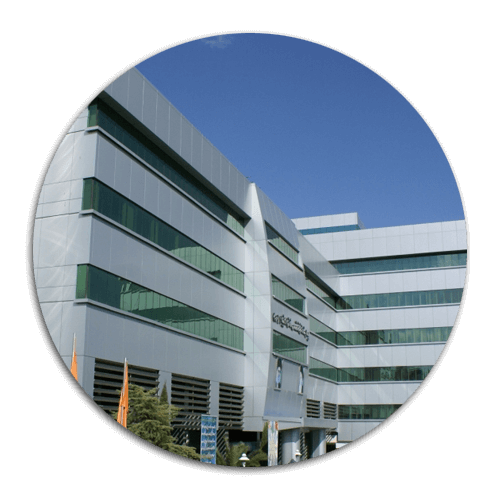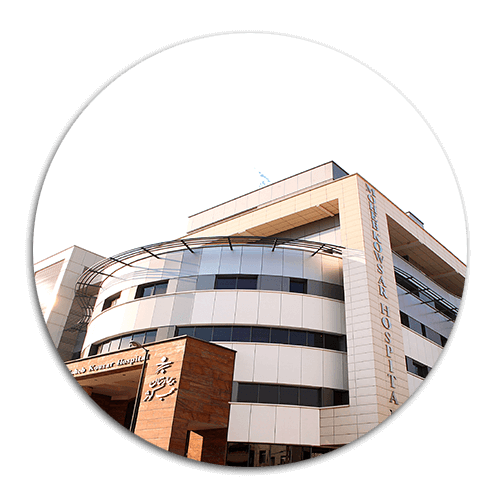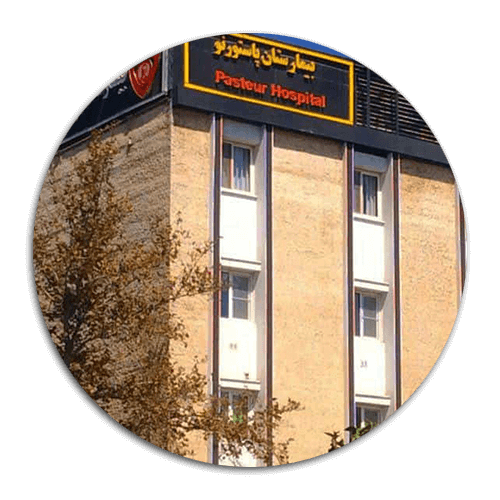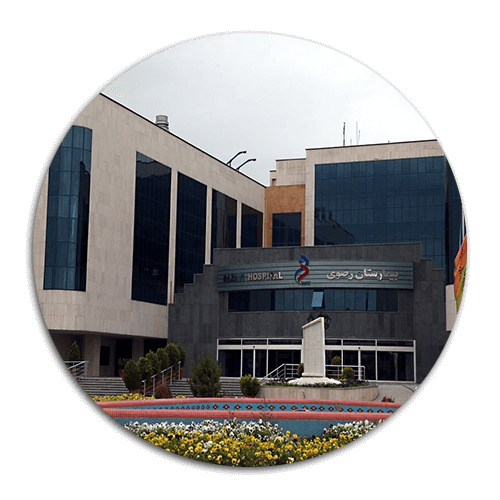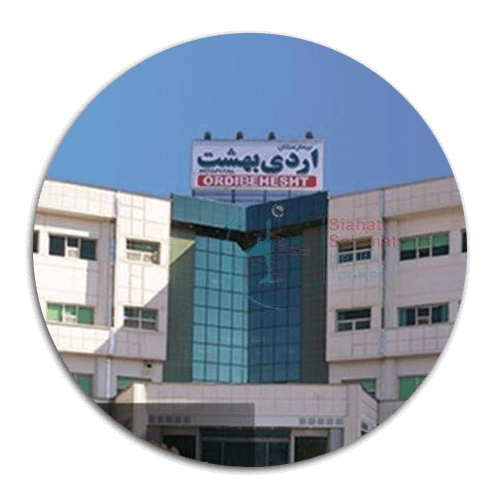Paget's disease of bone
Paget’s disease of bone is a chronic bone disorder that typically affects older adults. It is characterized by abnormal bone remodeling, resulting in the excessive breakdown and formation of bone tissue. This leads to the affected bones becoming enlarged, misshapen, and weakened, increasing the risk of fractures.
Paget’s disease of bon treatment in Iran
In Iran, Paget’s disease of bone is treated using medication, supportive therapies, and, in some cases, surgery. Medications like bisphosphonates are commonly used to regulate bone remodeling. Supportive therapies such as physiotherapy may be recommended, and surgical interventions may be considered for complications or severe symptoms. Treatment plans vary based on individual cases and should be discussed with healthcare professionals.
Symptoms of Paget’s disease of bone
Paget’s disease of bone can involve a single bone or multiple bones, with commonly affected areas including the pelvis, spine, and skull.
Symptoms of the disease can manifest as:
- Bone or joint pain
- Warm sensation over the affected bone
- Alterations in bone shape
- Shooting pain, numbness, tingling (peripheral neuropathy), or balance issues that radiate along or across the body
However, in many instances, there are no noticeable symptoms, and the condition is incidentally discovered during medical tests conducted for other reasons.
When to see your GP
If you experience any of the following, it is recommended to consult your GP:
- Persistent bone or joint pain
- Deformities in any of your bones
- Symptoms indicating a nerve problem, such as numbness, tingling, or balance issues
Your GP will be able to arrange tests to examine your bones and investigate potential conditions like Paget’s disease of bone.
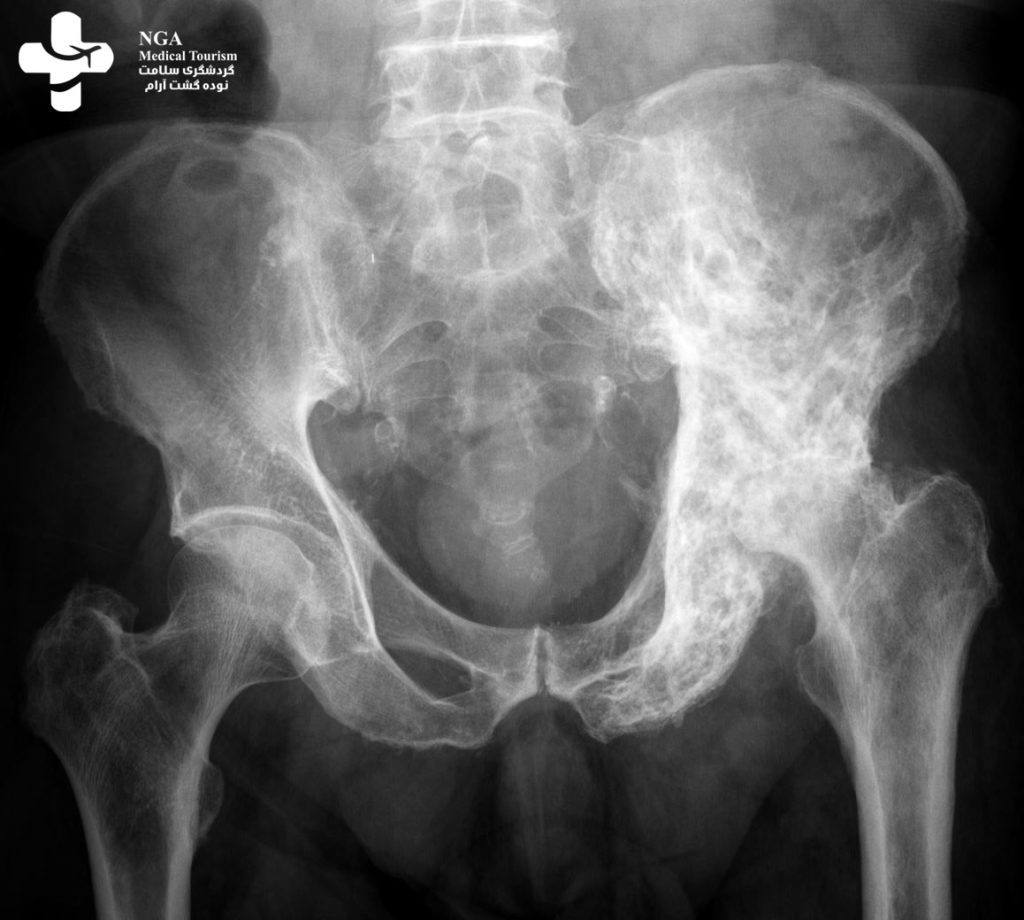
Causes of Paget’s disease of bone
Bone remodeling, which involves the removal of old bone and the formation of new bone, is a process similar to skin regeneration. Two types of cells play a role in this process:
- Osteoclasts: These cells are responsible for absorbing old bone.
- Osteoblasts: These cells are involved in the production of new bone.
In Paget’s disease of bone, there is a disruption in the normal function of osteoclasts. They begin to absorb bone at a faster rate than usual. As a result, osteoblasts attempt to compensate by producing new bone at an accelerated pace. However, the new bone formed is larger and weaker than normal bone.
The exact cause of this condition is not fully understood, but individuals with a family history of Paget’s disease of bone are at a higher risk. It is possible to inherit a genetic mutation that increases the likelihood of developing the condition.
Treatments for Paget’s disease of bone
Currently, there is no known cure for Paget’s disease of bone, but treatment options are available to help manage the symptoms associated with the condition.
If you are asymptomatic, your doctor may recommend monitoring your condition and delaying treatment until symptoms arise.
The primary treatment approaches include:
- Bisphosphonate medication: These medications are used to control bone remodeling and help alleviate pain associated with Paget’s disease.
- Supportive therapies: Physical therapy, occupational therapy, and assistive devices like walking sticks or shoe inserts can provide support and improve mobility.
- Surgery: In cases where complications such as fractures, deformities, or severe joint damage occur, surgical intervention may be necessary.
In addition, ensuring an adequate intake of calcium and vitamin D is important. Some individuals may need to take supplements to meet their nutritional needs.
Further problems caused by Paget’s disease of bone
Paget’s disease of bone can lead to various complications, some of which can be potentially serious. These complications may include:
- Fragile bones: The affected bones may become weak and more prone to fractures.
- Osteoarthritis: Paget’s disease can contribute to the development of osteoarthritis, which can cause joint pain and stiffness.
- Enlarged or misshapen bones: The excessive bone growth associated with the condition can lead to enlarged or deformed bones, affecting their normal structure and function.
- Hearing loss: If the skull is affected by Paget’s disease, it can lead to permanent hearing loss.
- Heart problems: In some cases, the excessive blood flow to the affected bones can put extra strain on the heart, potentially leading to heart problems.
- Bone cancer (rare): Although rare, Paget’s disease of bone has been associated with an increased risk of developing bone cancer.
It’s important to note that not all individuals with Paget’s disease will experience these complications. Regular monitoring and appropriate management can help reduce the risk and impact of these potential problems.
Other types of Paget’s disease
Yes, you are correct. In addition to Paget’s disease of bone, there are other types of Paget’s disease that affect different areas of the body. These include:
Paget’s disease of the nipple or breast:
This is a rare form of breast cancer that starts in the ducts of the breast and affects the skin of the nipple and areola. It may cause symptoms such as redness, itching, scaling, and crusting of the nipple area.
Paget’s disease of the penis:
This is a rare form of penile cancer that affects the skin of the penis, typically starting around the glans or foreskin. It can cause symptoms such as redness, itching, ulceration, and discharge from the affected area.
Paget’s disease of the vulva:
This is a rare form of vulval cancer that affects the skin of the vulva, the external female genital area. It may present with symptoms such as itching, burning, redness, and thickened skin in the vulval region.
It’s important to note that these types of Paget’s disease are distinct from Paget’s disease of bone and involve different underlying mechanisms and treatments. The term “Paget’s disease” is sometimes used specifically to refer to Paget’s disease of bone, but it’s important to clarify the specific type when discussing or researching the condition.

Symptoms Paget’s disease of bone
Paget’s disease of bone can manifest with various symptoms, but it can also be asymptomatic in some cases. The symptoms that may occur include:
- Bone or joint pain: This can range from mild discomfort to severe pain and is often localized to the affected bone or joint.
- Nerve compression symptoms: If the enlarged bones of Paget’s disease compress or irritate nearby nerves, it can lead to symptoms such as tingling, numbness, weakness, or radiating pain along the affected nerve pathway. This is known as neuropathy.
However, it’s important to note that many people with Paget’s disease of bone may not experience any noticeable symptoms, especially in the early stages. In such cases, the condition may only be detected incidentally during routine imaging or blood tests.
Paget’s disease of bone can affect one or multiple bones, with certain areas being more commonly involved. These commonly affected areas include the pelvis, spine, skull, shoulders, and legs. However, any bone in the body can potentially be affected by the disease.
It’s essential to consult a healthcare professional for an accurate diagnosis if Paget’s disease of bone is suspected, even in the absence of obvious symptoms.
Bone or joint pain
Indeed, Paget’s disease of bone can cause pain in the affected bone as well as in the joints adjacent to the affected bone. The characteristics of bone pain associated with Paget’s disease include:
Dull or aching pain: The pain is often described as a persistent, non-specific ache.
Deep within the affected area: The pain is usually localized to the specific bone involved in the disease process.
Constant pain: The discomfort is typically present continuously rather than intermittent.
Increased pain at night: Pain may intensify during nighttime or periods of rest.
In addition to bone pain, the affected area may feel warm to the touch. This localized warmth can be attributed to the increased blood flow and metabolic activity in the affected bone due to the abnormal bone remodeling process associated with Paget’s disease.
It’s important to consult a healthcare professional if you experience persistent bone or joint pain, especially if accompanied by other symptoms or concerns. They can evaluate your symptoms, conduct appropriate tests, and provide an accurate diagnosis and treatment plan if necessary.
Nerve problems
Abnormal bone growth in Paget’s disease can lead to compression or damage of nearby nerves, which can result in various symptoms. These can include:
- Pain radiating from the spine down into the legs: This is known as sciatica and is characterized by sharp or shooting pain that follows the path of the affected nerve.
- Numbness or tingling in the affected limbs: Peripheral neuropathy can cause sensations of numbness, tingling, or a “pins and needles” feeling in the arms, legs, hands, or feet.
- Partial loss of movement in the limbs: Compression of nerves can lead to muscle weakness or difficulty in controlling certain movements.
- Balance problems: Nerve involvement can affect coordination and balance, leading to difficulties in maintaining stability.
- Loss of bowel or bladder control: In severe cases, nerve compression can result in the loss of control over bowel movements (bowel incontinence) or bladder function (urinary incontinence).
If you experience sudden partial loss of movement in your limbs or loss of bowel or bladder control, it is crucial to seek immediate medical attention.
It’s important to note that these symptoms are relatively rare in Paget’s disease, but if they do occur, prompt medical assessment is essential.
Other problems
Paget’s disease of bone can indeed lead to various complications, including:
- Fragile bones: The abnormal bone remodeling in Paget’s disease can result in weakened bones that are more susceptible to fractures.
- Osteoarthritis: The excessive bone growth and structural changes can cause damage to the joints, leading to osteoarthritis. This can result in joint pain, stiffness, and reduced mobility.
- Deformities in affected bones: As the bone undergoes abnormal remodeling, it can lead to deformities in the affected areas. For example, the legs may become curved (bow legs) or the spine may develop a curvature (scoliosis).
- Skull involvement and related symptoms: If the skull is affected by Paget’s disease, it can lead to various symptoms such as hearing loss, headaches, vertigo (a spinning sensation), and tinnitus (ringing or buzzing in the ears).
- Heart problems: In some cases, Paget’s disease can affect the blood vessels in the bones, leading to increased blood flow and potential strain on the heart.
It’s important to note that not all individuals with Paget’s disease will experience these complications, and the severity can vary. Regular monitoring, appropriate management, and early intervention can help prevent or minimize these potential problems. If you have concerns about complications related to Paget’s disease, it is advisable to consult with your healthcare provider for personalized advice and guidance.
When to see a GP
If you are experiencing persistent bone or joint pain, deformities in your bones, or symptoms suggestive of a nerve problem, it is recommended to see your GP (general practitioner) for further evaluation. Your GP can assess your symptoms, conduct a physical examination, and order appropriate tests to investigate the underlying cause, including the possibility of Paget’s disease of bone.
During the diagnostic process, your GP may consider various factors, including your medical history, family history, and presenting symptoms. They may order blood tests to assess specific markers related to bone health, such as alkaline phosphatase levels. Imaging tests, such as X-rays, bone scans, or CT scans, may also be recommended to visualize the affected bones and identify any abnormalities.
If Paget’s disease of bone is suspected, your GP may refer you to a specialist, such as a rheumatologist or orthopedic surgeon, for further evaluation and management. The specialist will provide a more detailed assessment, confirm the diagnosis, and discuss appropriate treatment options.
It’s important to consult with a healthcare professional for an accurate diagnosis and personalized advice based on your specific symptoms and medical history.
Diagnosis Paget’s disease of bone
Paget’s disease of bone can be diagnosed with a blood test and an X-ray or scan.

ORTHOPEDIC SURGERY COST IN IRAN
Due to various factors, the cost of Orthopedic surgery in Iran is significantly lower compared to other countries. The price of orthopedic procedures may vary depending on the surgeon, hospital, and type of surgery. To provide an approximate estimate, the average cost of various orthopedic surgeries in Iran is as follows:
– Knee Replacement: $1600 – $5000
– Hip Replacement: $1600 – $3200
– Herniated Disc Surgery: $1500 – $2000
– Canal Stenosis Surgery: $1600 – $3000
– ACL Surgery: $1000 – $3000
– Bunion Surgery: $1500 – $2000
– Osteotomy: $1200 – $1500
– Internal Fixation of Bones: $300 – $600
– Carpal Tunnel Release: $600 – $1000
– Cervical Fracture Surgery: $1600 – $2500
Blood test
A blood test can be conducted to measure the level of alkaline phosphatase (ALP) in your blood, which can provide initial information regarding the possibility of Paget’s disease of bone. Elevated levels of ALP are commonly observed in individuals with Paget’s disease, although it’s worth noting that some people with the condition may have normal ALP levels, and elevated ALP can also be caused by other conditions.
To confirm the diagnosis of Paget’s disease of bone, an X-ray or scan is typically required. These imaging tests allow for a more detailed evaluation of the affected bones, revealing any characteristic changes associated with Paget’s disease.
It is essential to consult with a healthcare professional who can interpret the results of the blood test and imaging studies accurately, provide a definitive diagnosis, and recommend appropriate management strategies based on your individual circumstances.
X-ray and bone scan
X-ray imaging is commonly used to assess whether there is bone enlargement associated with Paget’s disease. By capturing detailed images of the affected bones, X-rays can reveal any changes in size, shape, and density that may be indicative of the condition.
In addition to X-rays, a bone scan called scintigraphy is often performed to determine the extent of Paget’s disease throughout the body. During this procedure, a small amount of a radioactive substance is injected into the bloodstream. This substance accumulates in areas where there is active bone remodeling. A gamma camera is then used to detect the emitted radiation and produce images that highlight the regions affected by the disease.
These imaging techniques, along with other diagnostic assessments, help healthcare professionals accurately diagnose and evaluate the extent of Paget’s disease of bone. It is important to consult with your healthcare provider who can interpret the results and guide you through the appropriate treatment and management options based on your specific situation.
Further tests
In certain situations where the diagnosis of Paget’s disease of bone is uncertain or if there are concerns about potential complications, additional tests may be recommended. These tests can provide more detailed information and aid in making a more accurate diagnosis. The following are some of the tests that may be conducted:
- Bone biopsy: This procedure involves the removal of a small sample of bone under anesthesia. The sample is then examined in a laboratory to evaluate it in detail and confirm the presence of Paget’s disease.
- CT scan (Computed Tomography): A series of X-ray images of the affected bone are taken from different angles. These images are combined to create a three-dimensional, detailed view of the bone, which can help in assessing the extent and characteristics of the disease.
- MRI scan (Magnetic Resonance Imaging): This imaging technique uses a strong magnetic field and radio waves to generate highly detailed images of the affected bone. MRI scans can provide information about the bone structure, surrounding soft tissues, and any potential complications associated with Paget’s disease.
These additional tests are typically recommended in specific cases to gather more information and assist in making informed decisions regarding treatment and management. Your healthcare provider will determine the necessity of these tests based on your individual circumstances and symptoms.
Treatment Paget’s disease of bone
While there is no cure for Paget’s disease of bone, various treatment options are available to manage the symptoms and minimize complications. The approach to treatment depends on several factors, including the severity of symptoms, the bones affected, and the risk of complications. Here are some common treatment strategies:
- Medications: Bisphosphonates are commonly prescribed to regulate bone remodeling and reduce pain. These medications help to slow down bone breakdown and improve bone strength. Other medications, such as calcitonin or pain relievers, may be used to manage pain and inflammation.
- Supportive therapies: Physical therapy and occupational therapy can help improve mobility, relieve pain, and enhance overall functioning. Assistive devices like walking aids, shoe inserts, or braces may also be recommended to provide support and alleviate discomfort.
- Surgery: In certain cases where complications arise, surgical intervention may be necessary. Surgery can be performed to repair fractures, correct deformities, or relieve pressure on nerves.
- Lifestyle modifications: Adopting a healthy lifestyle can contribute to better bone health. This may include regular exercise, a balanced diet rich in calcium and vitamin D, and avoiding activities that may increase the risk of fractures.
Bisphosphonates
Bisphosphonates are medications that regulate bone growth by targeting osteoclasts, the cells responsible for absorbing old bone. The most commonly prescribed bisphosphonate for Paget’s disease is zoledronate, administered as a single infusion through a drip in the arm. Zoledronate can provide pain relief for several years, and treatment can be repeated as needed.
Other bisphosphonates used include risedronate, taken orally as tablets, and pamidronate, given as injections. Side effects of zoledronate and pamidronate may include temporary flu-like symptoms, while upset stomach is a common side effect of risedronate.
Zoledronate can lower calcium levels, so calcium and vitamin D supplements are typically recommended for several days after the infusion. If bisphosphonates are not suitable, another medication called calcitonin may be prescribed, usually in the form of daily injections for up to 3 months to prevent bone loss.
Supportive therapies
Supportive therapies, including physiotherapy and occupational therapy, can provide significant benefits for individuals with Paget’s disease. These therapies involve exercises and techniques aimed at reducing pain, improving mobility, and enhancing the performance of daily activities.
In addition to these therapies, certain devices can help alleviate the weight and pressure on affected bones. Examples of such devices include walking sticks or frames, orthotics (plastic insoles that provide foot support within shoes), and braces that help maintain the proper position of the spine. These supportive measures can contribute to enhanced comfort and functionality for individuals living with Paget’s disease
Surgery
Surgery is typically reserved for cases where complications arise, such as fractures, deformities, or severe osteoarthritis, in individuals with Paget’s disease of bone.
Surgical procedures may involve:
- Realignment of fractured bones to promote proper healing.
- Replacement of a damaged joint with an artificial one, such as hip or knee replacement surgery.
- Correction of deformed bones by cutting and straightening them.
- Decompression of compressed nerves by moving bone away from the affected nerve.
These surgical interventions are usually performed under general anesthesia, ensuring that you are asleep and experience no pain during the procedure. The aim of surgery is to address specific issues associated with Paget’s disease and improve overall bone health and function.
Diet and nutrition
Adequate intake of calcium and vitamin D is essential for maintaining healthy bones, especially for individuals with Paget’s disease of bone. Here are some important points to consider:
- Calcium can be obtained from various dietary sources, including:
- Dairy products such as milk and cheese.
- Green leafy vegetables like broccoli and cabbage.
- Foods fortified with calcium, such as soya beans, calcium-fortified soya drinks, and tofu.
- Vitamin D is primarily synthesized by the body when exposed to sunlight. However, it is also present in certain foods, particularly oily fish.
- In some cases, your GP may recommend taking additional calcium and/or vitamin D supplements to ensure you meet the recommended intake.
By ensuring an adequate supply of calcium and vitamin D through diet and supplements, you can support bone health and potentially alleviate some symptoms associated with Paget’s disease of bone. It’s important to consult with your GP or healthcare provider to determine the appropriate supplementation and dosage based on your specific needs.
Complications Paget’s disease of bone
Paget’s disease of bone can sometimes lead to further problems.
Broken bones
Bones affected by Paget’s disease of bone are more susceptible to fractures, even with minor injuries, due to their increased fragility. If you experience a fracture, the following signs may indicate its occurrence:
- Sudden and intense pain.
- Swelling or tenderness around the injured area.
- Bleeding if the fractured bone has damaged the surrounding tissue and skin.
The effectiveness of bisphosphonate medication in preventing or treating fractures in Paget’s disease is not clear. In the event of a fracture, surgical intervention may be necessary to align the broken bones properly, facilitating correct healing.
If you suspect a fracture or experience any of the mentioned symptoms, it is crucial to seek medical attention promptly.

Osteoarthritis
Abnormal bone growth in Paget’s disease of bone can potentially harm the adjacent cartilage, which serves as a cushioning tissue for the joints. As a result, it can contribute to the development of osteoarthritis, commonly referred to as “wear and tear” of the joints. Osteoarthritis can manifest with the following symptoms:
- Joint pain: Individuals may experience discomfort and pain in the affected joints.
- Joint stiffness: Joints may feel rigid and less flexible, especially after periods of rest.
- Swollen joints: Inflammation can cause swelling and tenderness in the joints.
To learn more about the treatment options for osteoarthritis, it is advisable to refer to specific resources discussing osteoarthritis management and therapies.
Bone deformities
Paget’s disease of bone often leads to noticeable changes in the affected bones’ appearance. These changes can include:
- Enlarged or misshapen bones: The affected bones may grow larger and develop an abnormal shape.
- Bow legs: The legs may curve outward, giving them a characteristic bowed appearance.
- Scoliosis: The spine can develop a sideways curvature, leading to an abnormal posture.
- Kyphosis: The upper back may become excessively hunched over, resulting in a stooped posture.
While the role of bisphosphonates in preventing deformities is not fully understood, surgical intervention may be considered to correct any deformities that arise from Paget’s disease of bone. This can help improve the alignment and appearance of the affected bones.
Hearing loss
If Paget’s disease of bone affects the skull, there is a potential risk of permanent hearing loss, and in severe cases, it may even lead to total deafness. The hearing loss can occur due to damage to the bones or nerves responsible for transmitting sound signals from the ears to the brain.
It is not currently known whether treating Paget’s disease of bone directly reduces the risk of hearing loss. However, if the condition is affecting the skull and there are concerns about hearing impairment, treatment is typically recommended to manage and control the progression of the disease. This may involve a combination of medications, surgical interventions, and supportive therapies aimed at minimizing the impact on hearing function. Regular monitoring and follow-up with a healthcare professional are important to address any potential complications and ensure appropriate management of the disease.
Heart failure
In individuals with Paget’s disease of bone, the new bone formation often exhibits an increased number of blood vessels compared to normal bone. As a result, the heart may need to exert more effort to pump blood effectively throughout the body.
In very rare instances, the heart may become unable to pump an adequate amount of blood, leading to a condition known as heart failure. Symptoms associated with heart failure can include shortness of breath, extreme fatigue and weakness, and swelling in the legs, ankles, and feet (edema).
Treatment options for heart failure typically involve medications aimed at improving heart function and managing symptoms. In some cases, heart surgery may be necessary to address underlying issues contributing to heart failure. It is important to consult with a healthcare professional for a proper diagnosis and personalized treatment plan. Further information on the treatment of heart failure can be obtained from medical resources.
Bone cancer
Bone cancer is a rare but possible complication of Paget’s disease of bone, affecting approximately 1 in 500 to 1 in 1,000 individuals with the condition.
Symptoms of bone cancer share similarities with those of Paget’s disease of bone and can include bone pain, swelling around the affected bone, and the presence of a lump within the affected bone.
Osteosarcoma is a particularly severe form of bone cancer that has the potential to spread rapidly to other parts of the body. However, if it is detected at an early stage, it may be treatable through the surgical removal of the affected bone.
The best Paget’s disease bone hospitals in Iran | best orthopedic hospitals in iran
The best Paget’s disease bone surgeons in Iran
Frequently asked questions about Paget’s disease of bone
Surgical options for Paget’s disease of bone include corrective osteotomy, fracture fixation, joint arthroplasty, spinal decompression, and tumor resection. These procedures address long bone deformities, fractures, joint damage, spinal compression, and bone tumors, respectively. Corrective osteotomy involves repositioning the bone to correct deformities, while fracture fixation stabilizes fractured bones. Joint arthroplasty replaces damaged joints with artificial ones. Spinal decompression relieves pressure on compressed spinal nerves, and tumor resection removes bone tumors. Consulting with a healthcare professional is crucial to determine the appropriate surgical intervention based on individual circumstances.
Bisphosphonates are the primary treatment for Paget’s disease of bone, aimed at managing bone health and reducing symptoms. These drugs are commonly administered via intravenous injection or oral intake. Oral bisphosphonates are generally well-tolerated, although they may cause stomach irritation. The specific mode of administration will depend on individual circumstances and the healthcare provider’s recommendation. It’s important to follow the prescribed dosage and guidelines for optimal effectiveness and to minimize potential side effects.
Paget’s disease of bone can indeed impact the skull and spine, potentially resulting in the compression of nerves. This compression can lead to various symptoms associated with nerve impingement, such as pain, numbness, or weakness. Additionally, the disease can affect the small bones in the ear, potentially resulting in hearing loss or other auditory problems. The exact extent and severity of these complications can vary among individuals and may require specific medical attention and management.
Paget’s disease of bone has no cure, but treatment can help manage symptoms. If you’re asymptomatic, your doctor may recommend monitoring your condition and delaying treatment until symptoms appear.
Following surgical intervention, along with potential radiation therapy, additional treatment modalities such as chemotherapy, targeted therapy, or hormone therapy may be required.
The prognosis for Paget’s disease of the bone is generally favorable if it is diagnosed and treated early, before complications such as arthritis, fractures, and hearing loss have developed. Early intervention can significantly improve the outlook for individuals with this condition.



